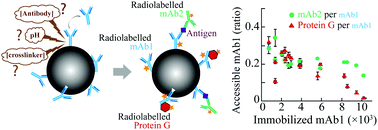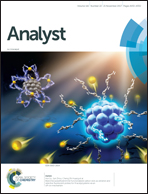The influence of covalent immobilization conditions on antibody accessibility on nanoparticles†
Abstract
The accessibility of particle-coupled antibodies is important for many analytical applications, but comprehensive data on parameters controlling the accessibility are scarce. Here we report on the site-specific accessibility of monoclonal antibodies, immobilized on magnetic nanoparticles (500 nm) by the widely used covalent EDC coupling method, with the variation of four key coupling parameters (surface activation and immobilization pH, crosslinker and antibody concentration ratios). By developing quantitative radio-labelled assays, the number of immobilized antibodies, the Fab domain accessibility (in a sandwich immunoassay), and the Fc domain accessibility (in a Protein G assay) were determined. For sub-monolayer surface coverage, the observed numbers of accessible Fab and Fc domains are equal and scale linearly with the antibody density. For above monolayer coverage, the fractions of accessible Fab and Fc domains decrease, in an unequal manner. The results show that the antibody accessibility is primarily determined by the antibody surface density, rather than by chemical reactivity or the charge state, and that crowded conditions affect Fab and Fc accessibility in an unequal manner.



 Please wait while we load your content...
Please wait while we load your content...